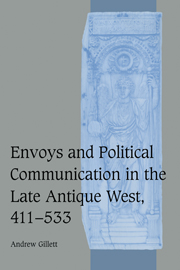Book contents
- Frontmatter
- Contents
- List of tables
- Preface
- List of abbreviations
- Chronological table
- Maps
- 1 EMBASSIES AND POLITICAL COMMUNICATION IN THE POST-IMPERIAL WEST
- 2 THE PROVINCIAL VIEW OF HYDATIUS
- 3 THE HERO AS ENVOY: SIDONIUS APOLLINARIS' PANEGYRIC ON AVITUS
- 4 THE SAINT AS ENVOY: FIFTH- AND SIXTH-CENTURY LATIN BISHOPS' LIVES
- 5 CASSIODORUS AND SENARIUS
- 6 NEGOTIUM AGENDUM
- CONCLUSION
- Appendix I Chronology of Constantius, Vita Germani
- Appendix II Chronology of the life of Epiphanius of Pavia
- Appendix III Senarius' Letters of Appointment: Cassiodorus, Variae IV, 3 and 4
- Appendix IV The text of Senarius' Epitaph
- Note on editions, commentaries, and translations of major sources
- Bibliography
- Index
- Cambridge Studies in Medieval Life and Thought Fourth series
3 - THE HERO AS ENVOY: SIDONIUS APOLLINARIS' PANEGYRIC ON AVITUS
Published online by Cambridge University Press: 12 July 2009
- Frontmatter
- Contents
- List of tables
- Preface
- List of abbreviations
- Chronological table
- Maps
- 1 EMBASSIES AND POLITICAL COMMUNICATION IN THE POST-IMPERIAL WEST
- 2 THE PROVINCIAL VIEW OF HYDATIUS
- 3 THE HERO AS ENVOY: SIDONIUS APOLLINARIS' PANEGYRIC ON AVITUS
- 4 THE SAINT AS ENVOY: FIFTH- AND SIXTH-CENTURY LATIN BISHOPS' LIVES
- 5 CASSIODORUS AND SENARIUS
- 6 NEGOTIUM AGENDUM
- CONCLUSION
- Appendix I Chronology of Constantius, Vita Germani
- Appendix II Chronology of the life of Epiphanius of Pavia
- Appendix III Senarius' Letters of Appointment: Cassiodorus, Variae IV, 3 and 4
- Appendix IV The text of Senarius' Epitaph
- Note on editions, commentaries, and translations of major sources
- Bibliography
- Index
- Cambridge Studies in Medieval Life and Thought Fourth series
Summary
Will future races and peoples ever believe this?
– a Roman's letter annulled a barbarian's conquests.
Sidonius, Carm. vii, lines 310–11The response of modern critics to Sidonius' rhetorical question has been remarkably positive. In 439, three years of hostilities between the Goths of Toulouse and the empire ended through the intercession of Eparchius Avitus, then praetorian prefect of Gaul, later, briefly, emperor of the western half of the empire. Where the army had failed, Avitus succeeded by exercising his personal influence over the court of Toulouse. This, at least, is the version given by Sidonius in his Panegyric, delivered sixteen years later to celebrate the imperial consulate of his father-in law, Avitus.
With some reservations, Sidonius' version of the events of 439 generally has been accepted – a small victory for a poem described as possessing ‘a very moderate portion either of genius or of truth’. This acceptance reflects less Sidonius' credibility than the rarity of well-informed testimony of the relations between the empire and the barbarian settlers in the West in the mid-fifth century. The Panegyric on Avitus is an almost unique portrait of contacts between the Gallic aristocracy and the Gothic monarchy of Toulouse. Most of the political elements active in Hydatius' Gallaecia are present: regional aristocracy, civil and military imperial officers in the provinces, barbarian rulers and army, and the western imperial court in Italy (but not the Church, which has no role to play in the genre of poetic panegyric). The narrative of the poem is structured on incidents of political communication.
- Type
- Chapter
- Information
- Publisher: Cambridge University PressPrint publication year: 2003



